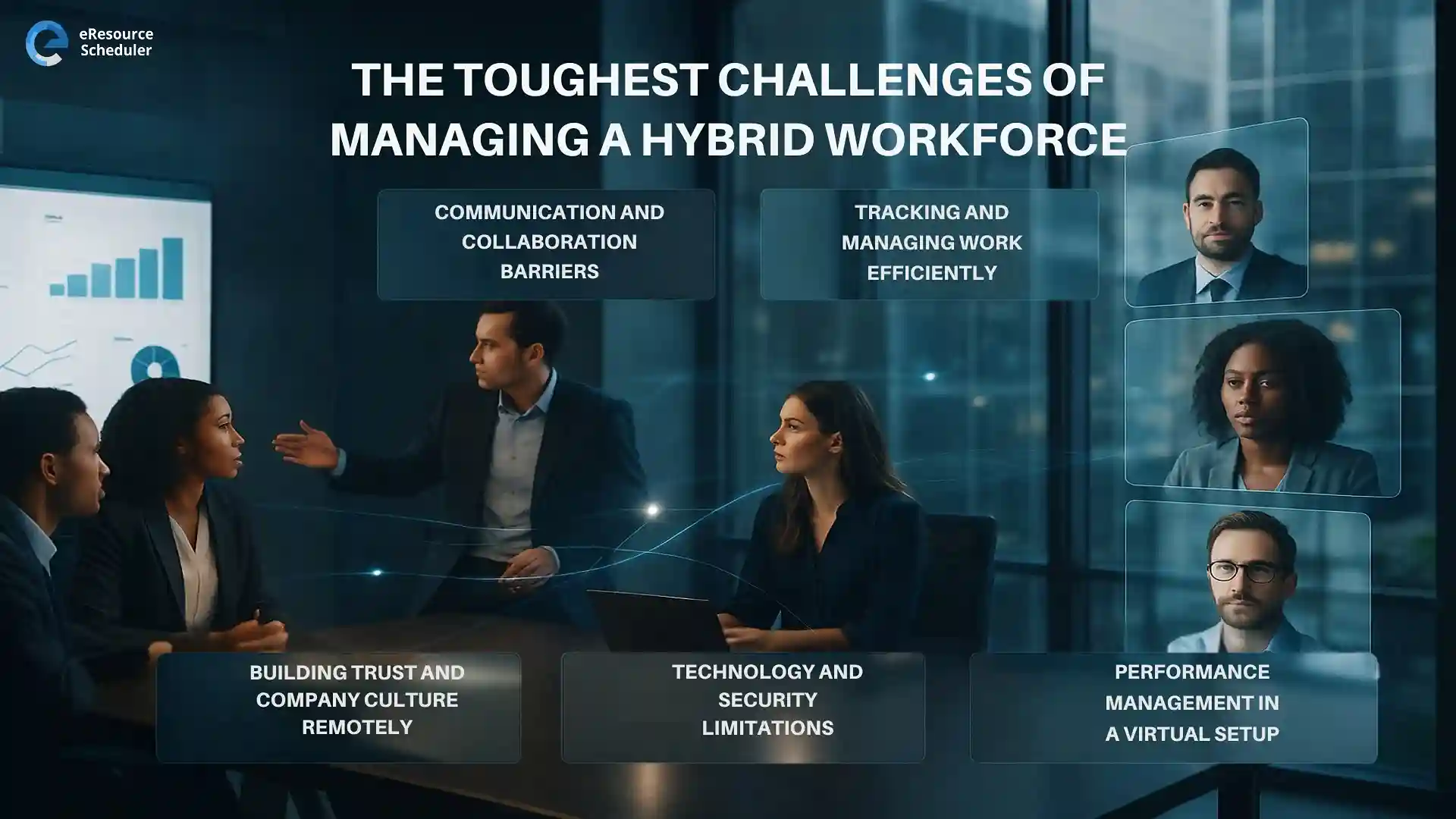
Managing a hybrid workforce sounds simple on paper. A little time at home, a little time at the office, and theoretically everyone lives happily ever after. Except reality has other plans. Once people spread across locations, schedules, and time zones, leaders suddenly need superpowers they were never trained for. Even something as basic as knowing who is working on what turns into a daily mystery, which is why many teams quietly lean on resource scheduling software just to make sense of the chaos.
Hybrid work is not the problem. The problem is how unpredictable everything becomes when half your team is on campus WiFi and the other half is negotiating with their router at home. Expectations blur. Communication patterns change. Some employees shine. Some disappear into silent emoji territory. And somewhere in the middle, U.S. managers are left juggling responsibilities that never existed in traditional offices.
So if managing a hybrid workforce feels harder than it is supposed to be, that is because it is.
Hybrid work was marketed like a dream.
A little home. A little office. A little freedom.
Your team gets the best of
both worlds and magically becomes more productive.
Yeah… no.
Somewhere between 2023 and 2026, hybrid work turned into a juggling act that managers were never trained for. It is basically the workplace version of “expectation versus reality.”
Here is what really happens inside hybrid teams:
Suddenly, managers are not just managing people.
They are managing environments, moods, schedules, and a whole lot of
uncertainty.
Hybrid work is unpredictable.
Your star performer at home might be unfocused in the office.
Your most distracted office worker might be a productivity machine in silence.
And the wild part is… none of this is obvious unless you are tracking closely.
It means:
Hybrid work is not a simple mix of remote and office life.
It is a whole new operating system, and everyone is still
downloading the instructions.

Hybrid work looks effortless from the outside. People get flexibility, offices stay less crowded, and everyone pretends balance is suddenly easy. But managers know the truth. Hybrid teams come with challenges that do not show up on job descriptions but definitely show up in day-to-day operations.
These challenges are not just inconvenient. They shape productivity, decision making, and team morale. And the first one hits harder than most leaders expect.
Communication was already tricky in fully remote teams. Hybrid work adds an extra layer of confusion because people switch environments, routines, and energy levels throughout the week.
When half the team is in the office and the other half is working from home, the flow of information becomes uneven. Some updates happen in passing. Some get typed out. Some get lost in meetings no one remembers agreeing to.
A few common patterns show up:
Collaboration becomes harder not because teams lack effort but because hybrid work changes how quickly people respond, how clearly they communicate, and how much information they naturally share.
The barrier is not silence. It is inconsistency. And inconsistent communication creates a ripple effect across every project.
Keeping track of work in a hybrid team sounds easy. It is not. People work at different times, update tools inconsistently, and assume everyone else already knows what is happening.
The real problem is visibility. When managers cannot see who is stuck, who is overloaded, or who finished early, even simple projects slow down.
Typical issues include:
Efficient tracking is not about watching people. It is about keeping work moving. Hybrid teams work better when routines are clear and everyone knows where updates actually go.
Hybrid work lives and dies on technology. When the tools behave, work flows. When they do not, productivity falls apart faster than a weak WiFi signal.
The challenge is that people work from different locations, networks, and devices. What feels smooth in the office can feel painfully slow at home. And every delay affects how fast teams move.
Common issues show up quickly:
Security becomes even trickier.
Home networks are not always protected.
Shared devices increase risks.
And one careless click can create a headache for the whole team.
Hybrid work technology does not have to be perfect. It just has to be reliable. When tools stay stable, teams stay focused.
Trust takes time to build in any workplace. In hybrid teams, it takes even more intention. People come in on different days, interact less often, and miss the small moments that usually strengthen relationships.
When teams barely overlap, it is easy for misunderstandings to grow. Someone’s short message feels cold. Someone’s quiet day feels disengaged. Someone’s absence in a meeting looks like a lack of interest when it was really just a scheduling clash.
Culture also becomes harder to maintain.
Office traditions change.
Team bonding becomes inconsistent.
And employees can feel disconnected from the bigger picture.
A few things make this tougher:
Hybrid culture succeeds when leaders create shared experiences, not just shared deadlines. When people feel included, trust grows naturally.
Evaluating performance in a hybrid environment becomes harder when managers cannot rely on the usual in office cues. Without daily face time, it is tougher to spot early signs of overload, confusion, or slipping priorities. Things that were obvious in the office now stay hidden until they grow big enough to disrupt timelines.
Hybrid teams often deal with a few recurring issues. Progress updates come in late, expectations feel unclear, and gaps in communication quickly affect accountability. Workload imbalances also become harder to notice because leaders cannot see who is quietly pushing through extra tasks and who is struggling to keep up.
This is why many organizations use resource capacity planning software to understand how work is distributed and where additional support may be needed. When managers can see workloads clearly, performance conversations become more objective and far less stressful for everyone involved.
Hybrid performance management does not require more check-ins.
It requires clearer systems that help teams stay aligned even when they work apart.
Hybrid work is not failing. It is evolving. What challenges managers today is not the concept of working from different places but the lack of clear systems that help teams stay aligned. When communication feels uneven, when work is hard to track, and when performance gets blurry, the entire workflow slows down.
The good news is that none of these challenges are permanent. With better routines, simple visibility, and consistent expectations, hybrid teams can move just as smoothly as traditional ones. In many cases, even better.
Managers do not need more tools or tighter control.
They need clarity and shared routines. When teams have that,
hybrid work becomes an advantage.
When teams have that, the hybrid model stops feeling complicated and starts feeling like an advantage. Book a demo of eResource Scheduler today and see how it transforms your hybrid workflow.
1. How do you keep hybrid teams connected?
You keep hybrid teams connected by using consistent communication routines that work both in office and remotely. Simple habits like shared updates, clear expectations, and structured team check-ins help reduce confusion and keep everyone aligned.
2. What makes hybrid work harder to manage?
Hybrid work becomes harder to manage when communication, visibility, and responsibilities are not clearly defined. Without shared systems, people easily miss updates or misunderstand priorities, which slows down collaboration.
3. How can managers track productivity in a hybrid setup?
Managers can track productivity by setting clear goals, using shared project tools, and checking in regularly without micromanaging. When expectations are transparent, teams stay focused even without daily in person supervision.
4. What tools help hybrid teams work better?
Tools that support communication, scheduling, and workload visibility help hybrid teams work better. They make it easier to understand who is doing what and prevent small issues from turning into project delays.
5. How do you maintain company culture in a hybrid workplace?
You maintain company culture by creating shared experiences, recognizing achievements, and making sure remote employees are included in conversations, decisions, and celebrations. Culture stays strong when people feel seen and connected, no matter where they work.
Plan Smarter. Schedule Faster.
Join thousands already using eResource Scheduler to align teams, time, and tasks seamlessly.